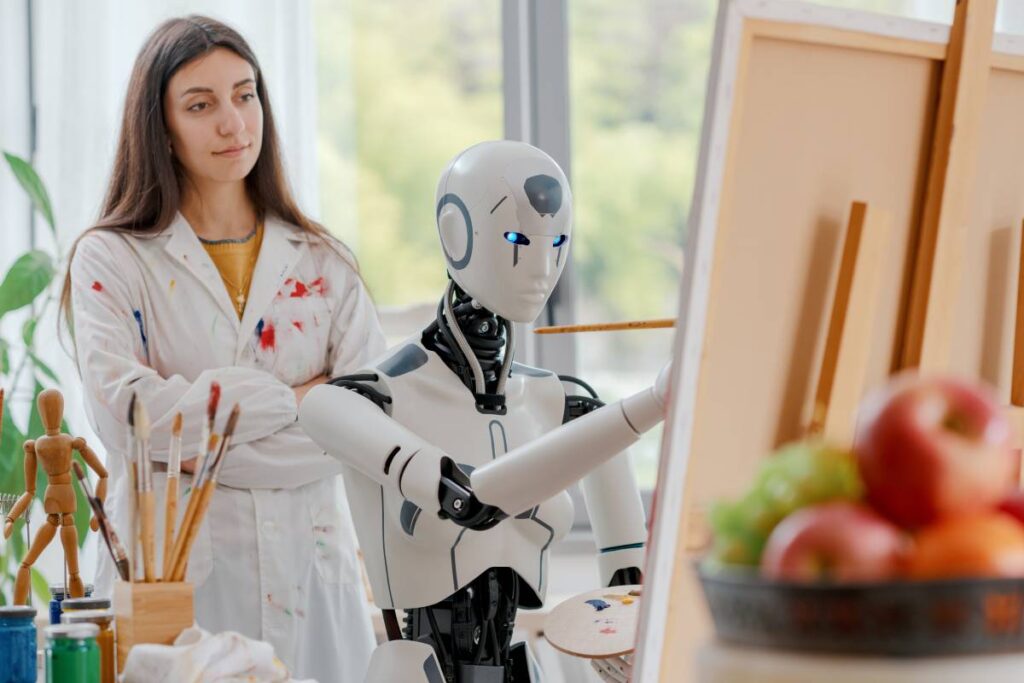Artificial intelligence, or AI, is no longer a concept confined to science fiction. It’s shaping how we live, work, and think, from voice assistants and medical diagnostics to art creation and financial forecasting.
But as AI grows more intelligent and intertwined with our lives, fundamental questions arise: What truly is AI? What lies at its core? Can it ever replace human intelligence, or will it always remain a tool that reflects us? Understanding these questions isn’t just about technology; it’s about the future of humanity itself.
What Is AI? The Heart of Artificial Intelligence and Its Future in Human Life
Artificial intelligence, or AI, has quickly become one of the most powerful and transformative forces in the modern world. From virtual assistants like Siri and ChatGPT to self-driving cars, AI is no longer a futuristic fantasy; it is shaping industries, economies, and even the way we think. But what exactly is AI? What lies at its heart? And as it continues to evolve, can it truly replace human intelligence, or will it remain a tool that complements us? Let’s explore the essence of AI, its potential, its limits, and what the future may hold.
What Is Artificial Intelligence?
Artificial intelligence is the science and engineering of creating machines or computer systems capable of performing tasks that would normally require human intelligence. These tasks include learning, reasoning, problem-solving, perception, and language understanding.
In simpler terms, AI enables computers to “think” in a limited sense to process data, recognize patterns, and make decisions without direct human intervention. The idea isn’t new. It dates back to the 1950s when pioneers like Alan Turing, John McCarthy, and Marvin Minsky began exploring how machines could simulate human thought. Turing’s famous question, “Can machines think?” laid the philosophical foundation for everything that followed.
Over the decades, AI has evolved through various stages:
- Rule-based systems (1950s–1980s): Early AI relied on pre-programmed rules. Machines could follow “if-then” logic, but couldn’t learn or adapt.
- Machine learning (1990s–2010s): With the rise of big data and improved computing power, AI systems began learning from examples instead of just following instructions.
- Deep learning (2010s–present): Inspired by the human brain, deep neural networks enabled breakthroughs in image recognition, speech processing, and natural language understanding.
Today, AI is everywhere, recommending what you should watch next on Netflix, helping doctors detect diseases earlier, translating languages in real time, and optimising everything from logistics to climate modelling.
The Heart of Artificial Intelligence
At the heart of AI lies data, algorithms, and computing power, three elements that work together to create intelligence from information.
Data: The Fuel of AI
Data is what AI “learns” from. Every image, sound, word, or number that a system processes helps it form patterns. The more high-quality data AI receives, the more accurate and capable it becomes. For instance, an AI model trained on millions of photos can learn to recognise faces, while one trained on billions of sentences can understand and generate natural language.
Algorithms: The Brain of AI
Algorithms are sets of instructions or mathematical models that tell AI how to interpret data. Modern algorithms, particularly neural networks, can mimic the way neurons in the human brain process signals. They enable AI to learn complex relationships — such as identifying emotions in speech or predicting stock market trends — without explicit programming.
Computing Power: The Muscle of AI
Powerful processors and cloud computing allow AI to process vast amounts of data quickly. This computational strength has fueled recent leaps in capability, from image-generation models to real-time language translation.
But beyond the technical core, the true heart of AI lies in its ability to learn and adapt. Unlike traditional software that performs static tasks, AI evolves. It refines its behavior over time through feedback, much like a human gaining experience. This adaptability is what makes AI revolutionary and also what makes it potentially unpredictable.
Can AI Replace Human Intelligence?

This question sits at the center of modern technological debate. While AI can perform many cognitive tasks faster and more accurately than humans, the answer is more complex than a simple “yes” or “no.”
Where AI Excels
AI outperforms humans in areas that require:
- Speed and precision: AI can process data and execute calculations millions of times faster than people.
- Pattern recognition: In fields like medical imaging, AI can detect microscopic anomalies that human eyes might miss.
- Repetition and endurance: AI never tires, making it ideal for repetitive tasks like quality inspection or data entry.
- Predictive analytics: By analyzing trends, AI can forecast outcomes — for example, predicting customer behavior or weather patterns.
In these domains, AI doesn’t just match human performance; it surpasses it.
Where Humans Still Lead
However, AI lacks many qualities that define human intelligence:
- Creativity: While AI can generate art, music, or text, it does so by remixing existing patterns. Genuine originality, the spark of inspiration, remains human.
- Emotional understanding: AI can simulate empathy, but doesn’t feel emotion. It can recognize a sad tone but doesn’t understand sadness.
- Ethics and morality: Machines don’t possess values or a conscience. They follow logic, not morality.
- Common sense: Humans can interpret context and ambiguity in ways that AI cannot. For example, understanding sarcasm or complex social dynamics still challenges machines.
Thus, while AI may replicate aspects of human thought, it doesn’t possess the consciousness or self-awareness that defines human intelligence. Rather than replacing humans, AI currently augments our abilities, making us faster, more informed, and more efficient.
The Relationship Between Humans and AI
The most promising view of AI is not as a rival but as a partner. This partnership can combine human creativity with machine efficiency. For instance:
- In healthcare, AI assists doctors in diagnosing diseases, but human judgment guides treatment decisions.
- In finance, algorithms detect fraud, while human analysts interpret results in context.
- In education, AI tutors personalize learning, but teachers nurture curiosity and emotional growth.
This synergy of human plus machine often produces results neither could achieve alone. The future likely belongs to those who can harness AI as a collaborator rather than fear it as a competitor.
Humans should be at the heart of AI.
Technology should enhance human potential, not replace it. The ultimate goal is not to create machines that think like us, but to design systems that work for us, tools that amplify creativity, compassion, and intelligence rather than diminish them.
Ethical and Societal Challenges of AI
As AI grows more capable, it raises profound ethical and social questions. Who is responsible if an AI system makes a harmful decision? How do we ensure fairness and prevent bias? What happens to jobs when automation expands?
Some major concerns include:
Bias and discrimination:
AI systems learn from data created by humans, and humans have biases. If that data reflects social inequalities, AI can unintentionally reinforce them, such as in hiring or lending algorithms.
Privacy and surveillance:
AI systems often rely on personal data. Without strong regulation, this could lead to mass surveillance or misuse of sensitive information.
Job displacement:
Automation threatens certain occupations, from factory work to administrative roles. While AI may create new jobs, the transition period could widen economic gaps.
Accountability:
When AI systems make decisions, for example, in self-driving cars or automated healthcare, determining legal and ethical responsibility becomes complex.
Addressing these issues will require transparency, global cooperation, and strong ethical frameworks. Governments, researchers, and companies must ensure that AI serves humanity rather than undermines it.
What Will Happen with AI in the Future?

Predicting the future of AI is challenging, but several trends are emerging that will define the next decade and beyond.
1. AI Will Become More Human-like
Advances in natural language processing, emotional recognition, and generative models are making AI more conversational and adaptive. Future AI may not just respond to commands but hold meaningful, empathetic dialogue. It will better understand human emotion, context, and nuance, making virtual assistants and customer service bots far more sophisticated.
2. Integration into Everyday Life
AI will be seamlessly integrated into homes, workplaces, and public systems. From personalized education to AI-driven healthcare diagnostics, it will quietly power the backbone of modern life. Wearable technology such as sleep trackers and fitness monitors already uses AI to analyze sleep cycles, heart rates, and lifestyle patterns, helping people make healthier choices through data-driven insights. Smart cities will use AI to manage traffic, energy, and public safety more efficiently.
3. AI and Creativity
Generative AI capable of producing text, music, video, and art will revolutionize creative industries. However, it will also challenge intellectual property laws and our understanding of originality.
4. Collaboration, Not Competition
Future AI systems will be designed to complement rather than replace humans. Fields like “human-in-the-loop” AI emphasize collaboration where human judgment remains integral to AI decision-making. This balance could define the next phase of progress.
5. Ethical AI and Global Regulation
The world will likely see stronger international frameworks to govern AI use, similar to environmental or nuclear treaties. The goal will be to ensure AI benefits humanity while minimizing risks. “Responsible AI” transparent, fair, and safe will become a guiding principle.
6. The Question of Conscious AI
A deeper philosophical question remains: could AI ever achieve consciousness or self-awareness? Most experts believe we’re still far from that reality. Current AI can simulate thought, but it doesn’t experience it. Still, as neural networks grow in complexity, society may one day need to redefine what it means to be “intelligent.”
Conclusion: The Human Heart in Artificial Intelligence
AI is not just a technological invention; it’s a reflection of human curiosity, our desire to replicate, enhance, and understand intelligence itself. The heart of AI beats with data and algorithms, but it is guided by human intention and ethics.
Can AI replace human intelligence? Not entirely. It can replicate tasks, mimic reasoning, and even outperform us in certain domains, but it lacks emotion, morality, and consciousness, the qualities that make us truly human.
The future of AI will depend on how we choose to use it. If guided wisely, AI can help solve global challenges from disease to climate change and elevate human potential. But if left unchecked, it could deepen inequality or blur the line between truth and fabrication.
Ultimately, Humans should be at the heart of AI, shaping its purpose, defining its limits, and ensuring it serves the greater good. The future of AI is, in truth, the future of humanity itself.











